Frederick Funston
Frederick Funston (November 9, 1865 – February 19, 1917), also known as Fighting Fred Funston, was a general in the United States Army, best known for his roles in the Spanish–American War and the Philippine–American War.[2] He received the Medal of Honor for his actions during the Philippine–American War.
Frederick Funston | |
|---|---|
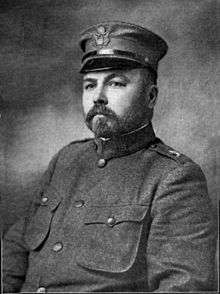 Major General Frederick Funston | |
| Nickname(s) | "Fearless Freddie"[1] |
| Born | November 9, 1865 New Carlisle, Ohio, U.S. |
| Died | February 19, 1917 (aged 51) San Antonio, Texas, U.S. |
| Place of burial | |
| Allegiance | |
| Service/ | |
| Years of service | 1898–1917 |
| Rank | |
| Commands held | Hawaiian Department |
| Battles/wars | Spanish–American War Philippine–American War Occupation of Veracruz Bandit War |
| Awards | |
| Spouse(s) | Eda Blankart Funston ( m. 1898) |
| Children |
|
Early life, education, and work
Funston was born in 1865 in New Carlisle, Ohio, to Edward H. Funston and Anne Eliza Mitchell Funston.[3] In 1867, his family moved to Allen County, Kansas. His father was elected to the United States House of Representatives in 1884 and served five terms.
Funston was a slight individual who stood 5 ft 4 in (1.63 m) tall and weighed only 120 pounds (54 kg) when he applied in 1886 to the United States Military Academy; he was rejected. Funston graduated from Iola High School in 1886.[4] He attended the University of Kansas from 1886 to 1890.[5] While there, he joined the Phi Delta Theta fraternity and became friends with William Allen White, who became a writer and won a Pulitzer Prize. He worked as a trainman for the Santa Fe Railroad before becoming a reporter in Kansas City, Missouri, in 1890.
Career
After one year as a journalist, Funston moved into more scientific exploration, focusing primarily on botany. First serving as part of an exploring and surveying expedition in Death Valley, California. In 1891, he then traveled to Alaska to spend the next two years in work for the United States Department of Agriculture.[3]
Cuba
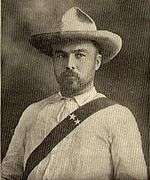
He eventually joined the Cuban Revolutionary Army that was fighting for independence from Spain in 1896[3] after having been inspired to join following a rousing speech given by Gen. Daniel E. Sickles at Madison Square Garden in New York City.
After a bout of malaria, Funston's weight dropped to an alarming 95 pounds. The Cubans gave him a leave of absence. When Funston returned to the United States, he was commissioned as a colonel of the 20th Kansas Infantry in the United States Army on May 13, 1898, in the early days of the Spanish–American War. In the fall, he met Eda Blankart at a patriotic gathering, and after a brief courtship, they married on October 25, 1898.[6] Within two weeks of the marriage, he had to depart for war, landing in the Philippines as part of the U.S. forces that would become engaged in the Philippine–American War.
Philippines
Funston was in command in various engagements with Filipino nationalists. In April 1899, he took a Filipino position at Calumpit by swimming the Bagbag River, then crossing the Pampanga River under heavy fire. For his bravery, Funston was soon promoted to the rank of brigadier general of Volunteers and awarded the Medal of Honor on February 14, 1900.
Funston played the key role in planning and executing the capture of Filipino President Emilio Aguinaldo on March 23, 1901, at Palanan. The capture of Aguinaldo made Funston a national hero, although the anti-imperialist faction criticized him when the details of the capture became known. Funston's party, escorted by a company of Macabebe scouts, had gained access to Aguinaldo's camp by posing as prisoners of Macabebe scouts. In recognition of his capture of Aguinaldo, Funston was appointed a brigadier general in the Regular Army at the age of 35. Funston's mission to capture Aguinaldo brought him a Regular Army commission just as he was scheduled to be mustered out of the volunteer service.
In 1902, Funston returned to the United States to increased public opposition to the Philippine–American War and became the focus of a great deal of controversy. Mark Twain, a strong opponent of U.S. imperialism, published a sarcasm-filled denunciation of Funston's mission and methods under the title "A Defence of General Funston" in the North American Review.[7] Poet Ernest Crosby also wrote a satirical, anti-imperialist novel, Captain Jinks, Hero, that parodied the career of Funston.[8]
Funston was considered a useful advocate for American expansionism, but when he publicly made insulting remarks about anti-imperialist Republican Senator George Frisbie Hoar of Massachusetts, mocking his "overheated conscience" in Denver, just before a planned trip to Boston, President Theodore Roosevelt denied his furlough request, and ordered him silenced and officially reprimanded.[9]
Sideco house (Emilio Aguinaldo's seat of First Philippine Republic)
The house was used as the seat of General Emilio Aguinaldo's First Philippine Republic; he established it as his headquarters in San Isidro during the last part of his escape from the American forces (after the Battle of Tirad Pass).
On March 29, 1899, Gen. Emilio Aguinaldo arrived in San Isidro, Nueva Ecija, and proclaimed the town as capital of the First Philippine Republic. He stayed in the house, using it as the de facto base of the Philippine government.
After the Americans occupied San Isidro, the Sideco house served as Funston's headquarters. He later captured General Aguinaldo in Palanan, Isabela. The Americans were said to have planned the actions in this house that led to General Aguinaldo's capture.[11][12] It is now occupied by a Christian organization.[11]
United States and overseas again
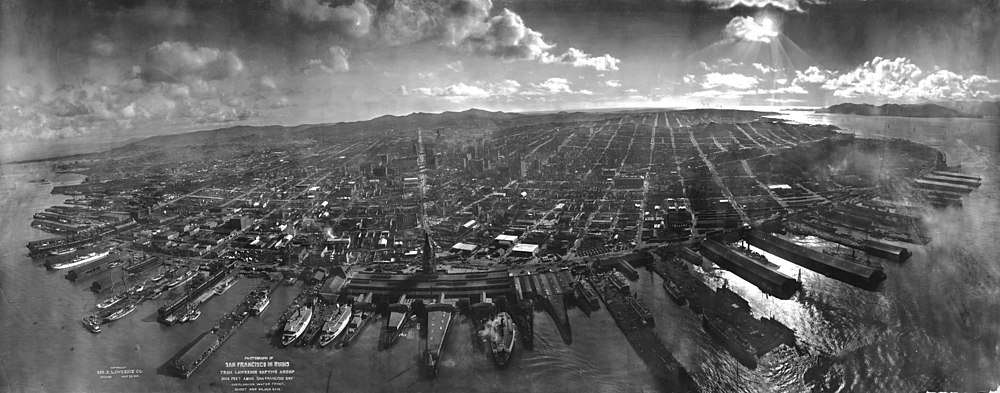
In 1906, Funston was commander of the Presidio of San Francisco when the 1906 San Francisco earthquake hit. He declared martial law, although he did not have the authority to do so, and martial law was never officially declared.[13] Funston attempted to defend the city from the spread of fire, and directed the demolition of buildings using explosives, including black powder, artillery charges, and dynamite, to create firebreaks. But Funston's orders often resulted in more fires.[14] Funston gave orders to shoot all looters on sight; however, these orders resulted in numerous cases of innocent people being shot.[14]
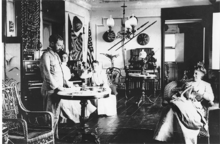
At the corner of Market and Third Streets on Wednesday I saw a man attempt to cut the fingers from the hand of a dead woman in order to secure the rings which adorned the stiffened fingers.
One man made the trooper believe that one of the dead bodies lying on a pile of rocks was his mother, and he was permitted to go up to the body. Apparently overcome by grief, he threw himself across the corpse. In another instant the soldiers discovered that he was chewing the diamond earrings from the ears of the dead woman ... The diamonds were found in the man's mouth afterward.
The soldiers do all they can, and while the unspeakable crime of robbing the dead is undoubtedly being practiced, it would be many times more prevalent were it not for the constant vigilance on all sides, as well as the summary justice.
– from survivors' accounts immediately following the 1906 Earthquake.[15]
At the time, local officials praised Funston's actions in the earthquake and fire emergency.[16] Historians have since taken issue with some of his actions in the disaster. Specifically, they argue that he should not have used military forces in a peacetime emergency.[17]
From December 1907 through March 1908, Funston was in charge of troops at the Goldfield mining center in Esmeralda County, Nevada, where the army put down a labor strike by the Industrial Workers of the World.
After two years as Commandant of the Army Service School in Fort Leavenworth, Funston served three years as Commander of the Department of Luzon in the Philippines. He was briefly shifted to the same role in the Hawaiian Department (April 3, 1913 to January 22, 1914).
Funston was active in the United States' conflict with Mexico in 1914 to 1916 as commanding general of the army's Southern Department, being promoted to major general in November 1914. He occupied the city of Veracruz. He commanded all forces involved in the hunt for Pancho Villa and providing security for the United States border with Mexico during the "Bandit War".
World War I and death

Shortly before the U.S. entry into World War I, President Woodrow Wilson favored Funston to head any American Expeditionary Force (AEF). His intense focus on work led to health problems, first with a case of indigestion in January 1917, followed by a fatal heart attack at the age of 51 in San Antonio, Texas.
In the moments before his death, Funston was relaxing in the lobby of The St. Anthony Hotel[18] in San Antonio, listening to an orchestra play The Blue Danube waltz. After commenting, "How beautiful it all is," he collapsed from a massive painful heart attack (myocardial infarction) and died. He was holding six-year-old Inez Harriett Silverberg in his arms.[19][20]
Douglas MacArthur, then a major, had the unpleasant duty of breaking the news to President Wilson and Secretary of War Newton D. Baker. As MacArthur explained in his memoirs, "had the voice of doom spoken, the result could not have been different. The silence seemed like that of death itself. You could hear your own breathing."
Funston lay in state at both the Alamo and the City Hall Rotunda in San Francisco. The latter honor gave him the distinction of being the first person to be recognized with this tribute, with his subsequent burial taking place in San Francisco National Cemetery. After his death, his position of AEF commander went to General John Pershing, who as commanding general of the Punitive Expedition in 1916 had been Funston's subordinate. The Lake Merced military reservation (part of San Francisco's coastal defenses) was renamed Fort Funston in his honor, while the training camp built in 1917 next to Fort Riley in Kansas (which became the second-largest World War I camp) was named Camp Funston. San Francisco's Funston Park and Funston Avenue are named for him, as is Funston Avenue in his hometown of New Carlisle, Ohio, and Funston Avenue near Fort Sam Houston in San Antonio. In Hawaii, Funston Road at Schofield Barracks and Funston Road at Fort Shafter are named after him. Funston's daughter, and his son and grandson, both of whom served in the United States Air Force, were later interred with him.
Medal of Honor citation
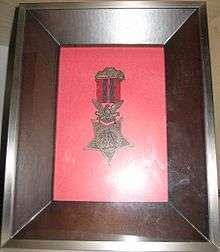
- Rank and organization
- Colonel, 20th Kansas Volunteer Infantry.
- Place and date
- At Rio Grande de la Pampanga, Luzon, Philippine Islands, April 27, 1899.
- Entered service at
- Iola, Kansas.
- Birth
- New Carlisle, Ohio.
- Date of issue
- February 14, 1900.
- Citation
- Crossed the river on a raft and by his skill and daring enabled the general commanding to carry the enemy's entrenched position on the north bank of the river and to drive him with great loss from the important strategic position of Calumpit.[21]
Legacy
Fort Funston in San Francisco, California, is named for him. There are streets named for Funston in San Francisco, in New Carlisle, Ohio, in Fort Leavenworth, Kansas, in Pacific Grove, California, and in Hollywood, Florida. Part of Fort Riley, Kansas, was also named for him.
In popular culture
- Portrayed by Troy Montero in the 2012 Filipino film El Presidente.
- Portrayed by Pablo Espinosa in the 1997 TNT television series Rough Riders.
- Mentioned once in The Woggle-Bug Book by L. Frank Baum published in 1905.
See also
- List of Philippine–American War Medal of Honor recipients
- A Defence of General Funston (Mark Twain's satirical essay).
References

- California Military Museum
- "FUNSTON, Frederick". The International Who's Who in the World. 1912. p. 483.
- Davis, Henry Blaine Jr. (1998). Generals in Khaki. Raleigh, North Carolina: Pentland Press, Inc. p. 397. ISBN 1571970886.
- "Biography, Frederick Funston". Frederick Funston Papers. Topeka, KS: Kansas Historical Society. Retrieved August 14, 2020.
- The Kansas Historical Quarterly. 40. Topeka, KS: Kansas State Historical Society. 1974. p. 189 – via Google Books.
- https://www.nps.gov/prsf/learn/historyculture/eda-blankart-funston.htm%7C Eda Blankart Funston
- Twain, Mark (May 1, 1902). "A Defence of General Funston". North American Review. 174. pp. 613–24. Retrieved March 4, 2005.
- "Crosby on Kipling: A Parody of "The White Man's Burden". Retrieved January 3, 2010.
- Miller (1982), p. 235; New York Times, April 10, 1902. Front-page headlines: Boston Herald, April 24, 1902: "President Muzzles Funston" and San Francisco Call, April 25, 1902: "Funston Silenced. President Orders Him to Cease Talking."
- "Discover Nueva Ecija". Philippines Department of Tourism. Retrieved March 4, 2015.
- Dumindin, Arnaldo (2006). "Philippine-American War, 1899–1902". Retrieved March 4, 2015.
- "The Sideco House in San Isidro (Nueva Ecija)". Local Philippines. Archived from the original on April 2, 2015. Retrieved March 4, 2015.
- Gordon Thomas & Max Morgan Witts: The San Francisco Earthquake (Stein and Day, New York; Souvenir Press, London, 1971; reprinted Dell, 1972, ISBN 081281360X, p. 83)
- Lafler, Henry Anderson. "How the Army Worked to Save San Francisco: An Attack on General Funston". Virtual Museum of the City of San Francisco. (Originally, Calkins Newspaper Syndicate, 1906). Retrieved 7 February 2013.
- Charles Morris: The San Francisco Calamity By Earthquake And Fire, 1906, reprinted by Citadel Press, New Jersey; 1986, pp. 79–80
- "Funston and Pershing, the Generals in Charge of the Chase After Villa". Current Opinion. May 1916.
...he and his officers and men won laurels for the Regular Army and evoked paeans of praise from the civil authorities of San Francisco
- Nobleman, Marc Tyler (2007). The San Francisco Earthquake of 1906. Capstone. p. 24. Retrieved 25 August 2018.
Historians feel that Funston made an error in judgment by calling in armed soldiers during a peacetime emergency.
- The Virtual Museum of the city of San Francisco
- [Friday, March 2, 1917, Greensboro Daily News (Greensboro, North Carolina) Page: 7]
- [Tuesday, February 20, 1917 Omaha World-Herald (Omaha, Nebraska) p. 1]
- "Medal of Honor recipients". United States Army Center of Military History. August 3, 2009. Retrieved January 6, 2010.
Further reading
- "Funston, Frederick" in The National Cyclopedia of American Biography, Vol. 11, Pages 40–41.
External links
| Wikimedia Commons has media related to Frederick Funston. |
| Wikisource has the text of a 1920 Encyclopedia Americana article about Frederick Funston. |
- "Funston biography on City of San Francisco Museum site". Retrieved September 29, 2010.
- "Major General Frederick Funston Boyhood Home & Museum, located in Iola, Kansas". Retrieved September 29, 2010.
- Photos and other items related to Frederick Funston are available on Kansas Memory, the digital portal of the Kansas Historical Society, Topeka, Kansas
- Frederick Funston papers are available at the Kansas Historical Society, Topeka, Kansas
- . New International Encyclopedia. 1905.
| Military offices | ||
|---|---|---|
| Preceded by John Frank Morrison |
Commandant of the Command and General Staff College January 1911 – February 1913 |
Succeeded by Ramsay D. Potts |